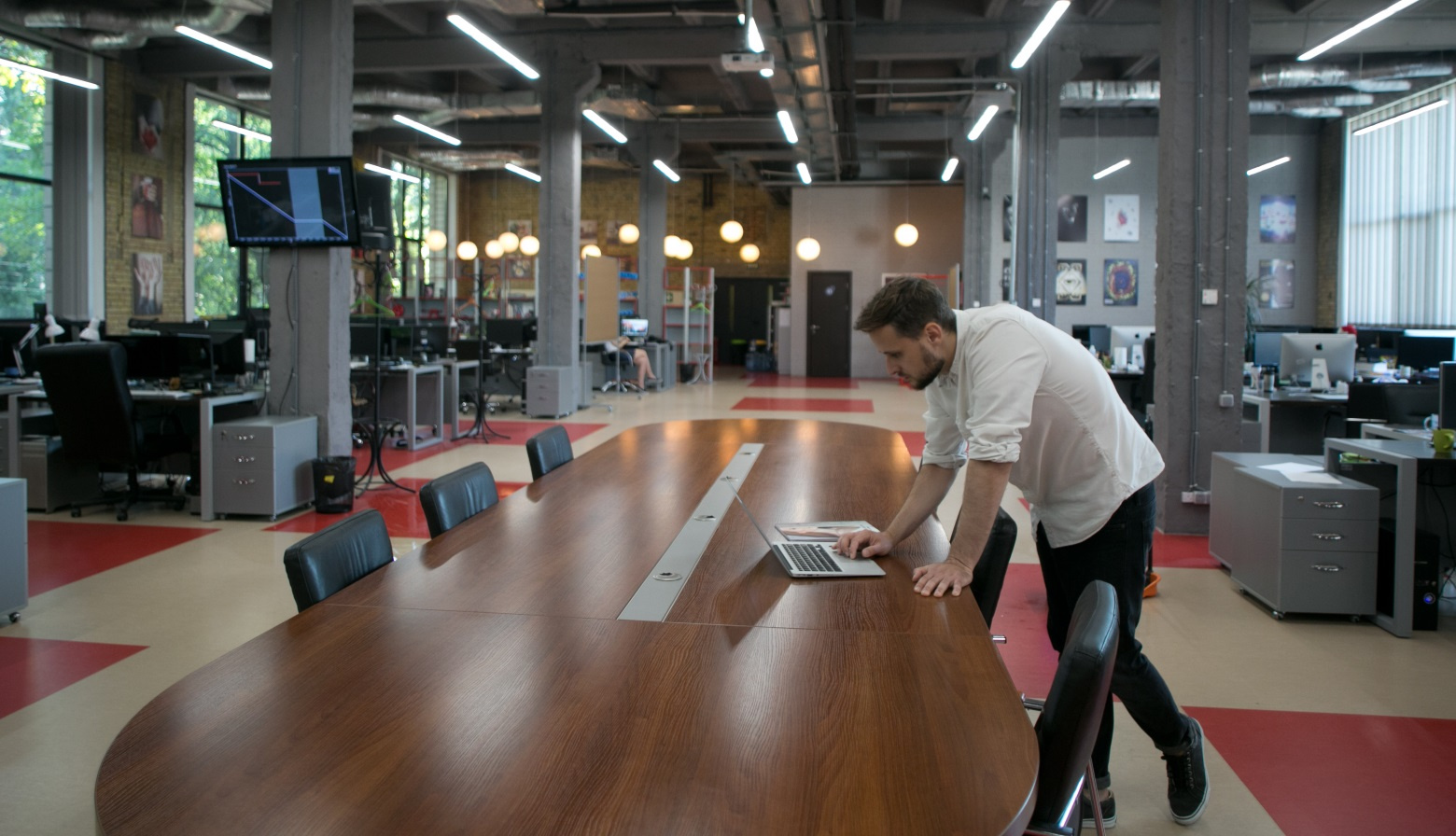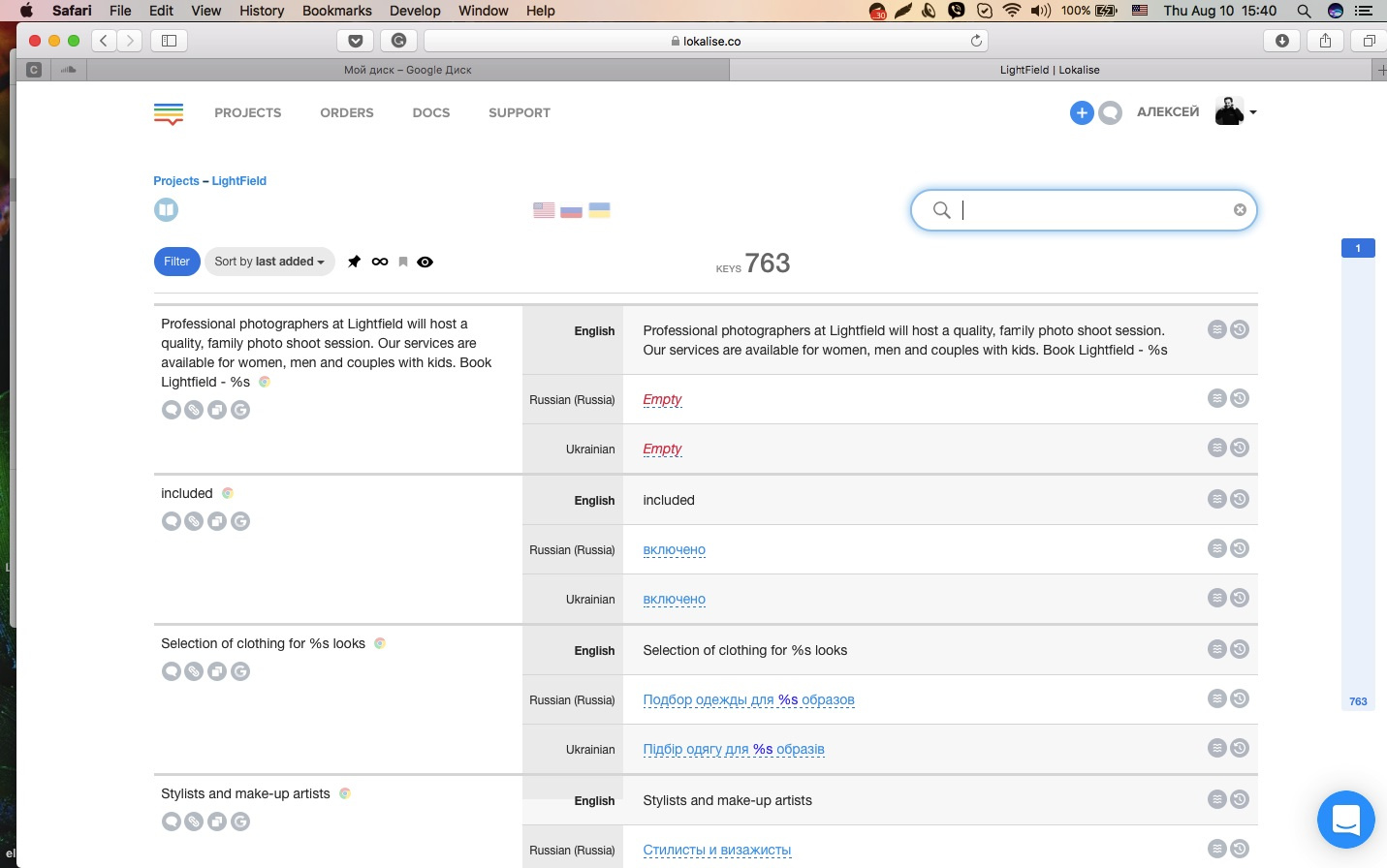Integration of Lokalise service into the largest photobank in the world: Depositphotos experience
To conquer the foreign market, business needs not only to translate texts and interfaces into other languages, but also to adapt the product to the current conditions of the region, taking into account all the features: currency, measurement system, dates, even traditions and religious nuances. Someone does everything on their own, someone hires translators (or better than native speakers), and someone uses professional localization platforms. One such automation and translation management service is Lokalise.. Experts from the popular international photo and video bank Depositphotos, localization manager Tatyana Grebenyuk and web developer Roman Drogolov, shared their implementation experience. The results of the conversations are conditionally presented in two parts, the first of which is devoted to the technical aspects of the development and integration of Lokalise in the project environment, and the second to the issues of translation and interaction with translators.

Depositphotos is an international photo and video bank founded by Ukrainian businessman Dmitry Sergeyev in 2009. The company has repeatedly attracted large investments from TMT Investments and the European Bank for Reconstruction and Development. Now the collection of Depositphotos files contains more than 67 million images and videos, and the company itself is present in two dozen markets around the world.
Now Depositphotos is already localized in 20 languages, and work is underway on two more language versions of the project - Thai and Indonesian. The photobank team decided to switch to an automated translation system about two years ago, and since then five internal projects of the company have been going through Lokalise: the site itself, the photobank’s mobile applications, the Crello graphic online editor, the Lightfield photo studio portal and social media posts.
Before moving to Lokalise, the team used a dedicated SQL database, which managed to grow to 120 thousand keys. Many of them were no longer needed, but it was not possible to remove them, since among such a variety of lines it was an impossible task to separate the necessary keys from the unnecessary ones. Roman Drogolov notes that after switching to Lokalise, the volume of the key database decreased by more than 25 times (to about 5 thousand), which can now be easily ordered and filtered by the necessary parameters. “When it was necessary to transfer the key database to Lokalise, we built-in logging of used strings and looked at which keys were used during the last 2 months in production. They were later uploaded to Lokalise, ”recalls the developer. According to him, of course, situations arose when it turned out
The transition to an automated service took about a week. During this time, scripts were written that were responsible for interacting with the new database on the Lokalise side, and the layer of caches on the project was slightly changed. After that, the service was fully integrated into the Depositphotos workflow.
The novel notes that for him one of the main advantages of Lokalise is the integration of web hooks into the project, and some of them his team was able to adapt to their needs. So, for example, they adapted Slack webhook for logging changes in localization keys. “Lokalise has pretty good use of the same keys for iOS, Android and the web at the same time. Our mobile developers are actively using this functionality, ”he notes.
The developer said that he almost never encountered conflicts with frameworks while working with Lokalise. The team uses the Phalcon framework, but it is very limited, and prefers it to hand-written tools. “In general, I would like to say that Lokalise has a very good and convenient API. Yes, he doesn’t have enough opportunities for filtering keys, but overall I am pleased with his work, ”says Roman Drogolov. He adds that there were problems, but they were quickly resolved.
In Depositphotos, at one time, there was a problem introducing restrictions on API requests in Lokalise. The team was “slightly” surprised when a number of scripts began to work incorrectly. “With us, both test and production servers can run several cache scripts at the same time, pulling together new translations. Due to the fact that requests come with a difference of half a second-second, the API blocked them and had to wait for the next automatic start to fill in a new localization, ”says Roman. However, time spacing helped overcome this inconvenience.

“In general, I want to say that the Lokalise support team works flawlessly. They answer questions very quickly - literally within an hour and a half, explain in some detail how to solve a particular problem, and always strive to find the most convenient way for us. Most often Nick Ustinov works with me on such issues, ”says Roman Drogonov (ed. - at the time of the conversation, Roman did not know that Nick Ustinov is the CEO of Lokalise).
Localization manager Depositphotos Depositphotos Tatyana Grebenyuk also shared her experience in interacting with the Lokalise service. She notes that Depositphotos started a switch to Lokalise to simplify the localization process for all its members, as well as make it fast and efficient. “We needed to be able to use the“ translation memory ”and restrict access by unauthorized people to the admin panel and key database. Of course, I did most of the work with the database, but sometimes, especially when the task was urgent, we had to give translators access to the database, and this, as you know, is fraught with problems of all kinds, ”recalls Tatyana. According to her, now that translators have access to the localization system, and at the same time there is no risk that they accidentally “break it”, it has become much easier for everyone to work:

The very idea of turning to Lokalise came about after CEO SEO had read material on the platform, and he found this interesting. Tatyana notes that then the desire to find a new whole localization platform and information about Lokalise surprisingly coincided, in addition, the price offers of the service were quite adequate.
Depositphotos Translation team has its own, grown from the very start of the project. According to Tatyana, the company has been cooperating with these people for more than 5 years, and 70% of them have been working in their own language since the beginning of localization. “These are people who know all the specifics of the project, and I only part with them in very exceptional cases,” she says. After the transition to a new system, the time for working on localization was halved. Previously, about 4 months of continuous work took one language, but now this period has decreased to 2-2.5 months. “This reduction was made possible due to the fact that translators work directly in the translation platform and I don’t need to pull out each key for them individually,” says Tatyana.
Now Depositphotos projects are localized in 20 languages and work is underway for two more - Thai and Indonesian. “Our work is structured as follows: translators get access to Lokalise, where they translate the main version into their language. After that, we upload the translation to the test server and give them access there too, so that they can see the final version of their work, comment and supplement their translations, if necessary, ”says Tatyana. She also notes that after such a test, translation in the same place, in Lokalise, is checked with the help of other online translators and independent experts for whom the target language is native (native speakers).
The Depositphotos manager, as the main advantages of the Lokalise service, notes ease of use, the ability to easily give translators access to the database, the presence of a translation history, and also filters by keys. “It’s convenient that there are comments here, you can tighten screenshots to provide the translator with the necessary context of a key. It’s also very important for me that I can safely hide a language if the work with it is completed at the current stage, ”says Tatyana.

At the same time, she would like for key filtering to be more finely tuned and more accurate, as well as for translation memory to be more flexible. “Given the volume of our projects, translators often get a little confused, translating a word. It would be nice if they had more than one translation option in the tooltip, but everything that was used in the current project, ”adds the Depositphotos manager. In addition, in her opinion, the service lacks the ability to create special “personalized” lists of keys for a particular task.
But despite some platform flaws, Depositphotos do not use other localization services and do not plan to leave with Lokalise. “Of course, as a project manager, I receive offers from other companies, but basically these are not platforms for working with our own translators, but regular translation services with freelance translators. For a project like us, this is not suitable. A stranger simply will not be able to understand many things, and a translation from just about anyone will not suit us, ”says Tatyana.

Depositphotos is an international photo and video bank founded by Ukrainian businessman Dmitry Sergeyev in 2009. The company has repeatedly attracted large investments from TMT Investments and the European Bank for Reconstruction and Development. Now the collection of Depositphotos files contains more than 67 million images and videos, and the company itself is present in two dozen markets around the world.
Now Depositphotos is already localized in 20 languages, and work is underway on two more language versions of the project - Thai and Indonesian. The photobank team decided to switch to an automated translation system about two years ago, and since then five internal projects of the company have been going through Lokalise: the site itself, the photobank’s mobile applications, the Crello graphic online editor, the Lightfield photo studio portal and social media posts.
Start
Before moving to Lokalise, the team used a dedicated SQL database, which managed to grow to 120 thousand keys. Many of them were no longer needed, but it was not possible to remove them, since among such a variety of lines it was an impossible task to separate the necessary keys from the unnecessary ones. Roman Drogolov notes that after switching to Lokalise, the volume of the key database decreased by more than 25 times (to about 5 thousand), which can now be easily ordered and filtered by the necessary parameters. “When it was necessary to transfer the key database to Lokalise, we built-in logging of used strings and looked at which keys were used during the last 2 months in production. They were later uploaded to Lokalise, ”recalls the developer. According to him, of course, situations arose when it turned out
The transition to an automated service took about a week. During this time, scripts were written that were responsible for interacting with the new database on the Lokalise side, and the layer of caches on the project was slightly changed. After that, the service was fully integrated into the Depositphotos workflow.
The novel notes that for him one of the main advantages of Lokalise is the integration of web hooks into the project, and some of them his team was able to adapt to their needs. So, for example, they adapted Slack webhook for logging changes in localization keys. “Lokalise has pretty good use of the same keys for iOS, Android and the web at the same time. Our mobile developers are actively using this functionality, ”he notes.
Difficulties and support
The developer said that he almost never encountered conflicts with frameworks while working with Lokalise. The team uses the Phalcon framework, but it is very limited, and prefers it to hand-written tools. “In general, I would like to say that Lokalise has a very good and convenient API. Yes, he doesn’t have enough opportunities for filtering keys, but overall I am pleased with his work, ”says Roman Drogolov. He adds that there were problems, but they were quickly resolved.
In Depositphotos, at one time, there was a problem introducing restrictions on API requests in Lokalise. The team was “slightly” surprised when a number of scripts began to work incorrectly. “With us, both test and production servers can run several cache scripts at the same time, pulling together new translations. Due to the fact that requests come with a difference of half a second-second, the API blocked them and had to wait for the next automatic start to fill in a new localization, ”says Roman. However, time spacing helped overcome this inconvenience.

“In general, I want to say that the Lokalise support team works flawlessly. They answer questions very quickly - literally within an hour and a half, explain in some detail how to solve a particular problem, and always strive to find the most convenient way for us. Most often Nick Ustinov works with me on such issues, ”says Roman Drogonov (ed. - at the time of the conversation, Roman did not know that Nick Ustinov is the CEO of Lokalise).
View of the localization manager Depositphotos
Localization manager Depositphotos Depositphotos Tatyana Grebenyuk also shared her experience in interacting with the Lokalise service. She notes that Depositphotos started a switch to Lokalise to simplify the localization process for all its members, as well as make it fast and efficient. “We needed to be able to use the“ translation memory ”and restrict access by unauthorized people to the admin panel and key database. Of course, I did most of the work with the database, but sometimes, especially when the task was urgent, we had to give translators access to the database, and this, as you know, is fraught with problems of all kinds, ”recalls Tatyana. According to her, now that translators have access to the localization system, and at the same time there is no risk that they accidentally “break it”, it has become much easier for everyone to work:

The very idea of turning to Lokalise came about after CEO SEO had read material on the platform, and he found this interesting. Tatyana notes that then the desire to find a new whole localization platform and information about Lokalise surprisingly coincided, in addition, the price offers of the service were quite adequate.
The specifics of working on localization
Depositphotos Translation team has its own, grown from the very start of the project. According to Tatyana, the company has been cooperating with these people for more than 5 years, and 70% of them have been working in their own language since the beginning of localization. “These are people who know all the specifics of the project, and I only part with them in very exceptional cases,” she says. After the transition to a new system, the time for working on localization was halved. Previously, about 4 months of continuous work took one language, but now this period has decreased to 2-2.5 months. “This reduction was made possible due to the fact that translators work directly in the translation platform and I don’t need to pull out each key for them individually,” says Tatyana.
Now Depositphotos projects are localized in 20 languages and work is underway for two more - Thai and Indonesian. “Our work is structured as follows: translators get access to Lokalise, where they translate the main version into their language. After that, we upload the translation to the test server and give them access there too, so that they can see the final version of their work, comment and supplement their translations, if necessary, ”says Tatyana. She also notes that after such a test, translation in the same place, in Lokalise, is checked with the help of other online translators and independent experts for whom the target language is native (native speakers).
Strengths of Lokalise, and what the service lacks
The Depositphotos manager, as the main advantages of the Lokalise service, notes ease of use, the ability to easily give translators access to the database, the presence of a translation history, and also filters by keys. “It’s convenient that there are comments here, you can tighten screenshots to provide the translator with the necessary context of a key. It’s also very important for me that I can safely hide a language if the work with it is completed at the current stage, ”says Tatyana.

At the same time, she would like for key filtering to be more finely tuned and more accurate, as well as for translation memory to be more flexible. “Given the volume of our projects, translators often get a little confused, translating a word. It would be nice if they had more than one translation option in the tooltip, but everything that was used in the current project, ”adds the Depositphotos manager. In addition, in her opinion, the service lacks the ability to create special “personalized” lists of keys for a particular task.
But despite some platform flaws, Depositphotos do not use other localization services and do not plan to leave with Lokalise. “Of course, as a project manager, I receive offers from other companies, but basically these are not platforms for working with our own translators, but regular translation services with freelance translators. For a project like us, this is not suitable. A stranger simply will not be able to understand many things, and a translation from just about anyone will not suit us, ”says Tatyana.
